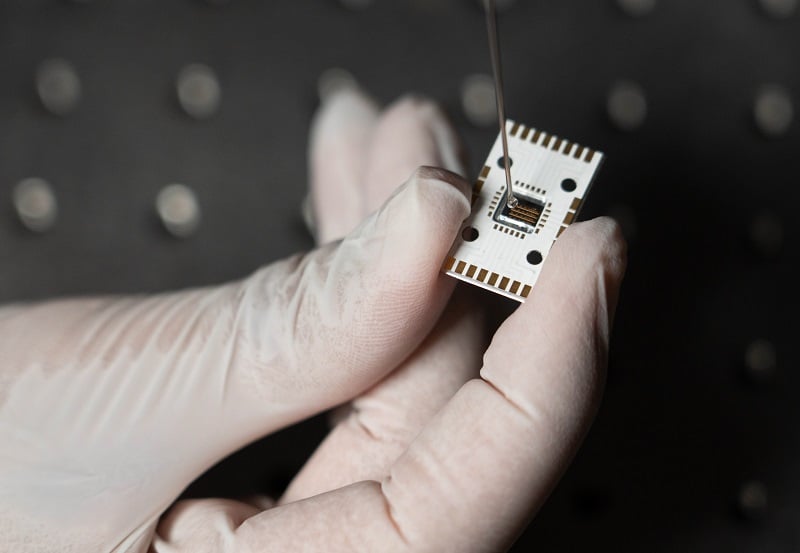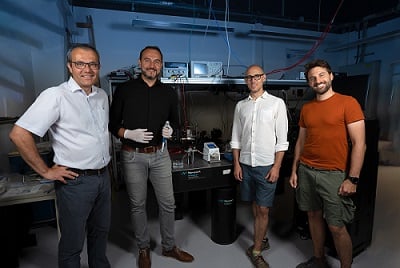Photonics HandbookTechnology News
Tiny IR Spectrometer Improves Sensitivity, Speed of Liquid Analysis
Analytical chemistry often requires the accurate measurement of concentration changes of substances in liquids, on a timescale of seconds. Particularly in the pharmaceutical industry, such measurements need to be extremely sensitive and reliable.
A fingerprint-size spectroscopy sensor developed at the Vienna University of Technology (TU Wien) has been shown to be highly suitable for this task. Based on infrared technology, the device is significantly more sensitive compared to previous devices. Further, it can be used for a wide range of molecule concentrations and can operate directly in the liquid.

Sensor chip mounted on an aluminum circuit board. Courtesy of TU Wien/Hurnaus.
“To measure the concentration of molecules, we use radiation in the mid-infrared spectral range,” said Borislav Hinkov of the Institute of Solid-State Electronics at TU Wien and head of the research project.
Infrared spectroscopy has been used in gas sensing for a long time. The achievement of the team at TU Wien is the implementation of this technology on a fingertip-size sensor chip specifically suited for liquid sensing. Developing such a sensor was a technological and analytical challenge because liquids absorb much more infrared radiation than gases. The compact liquid sensor was realized in collaboration with Benedikt Schwarz from the Institute of Solid-State Electronics and fabricated in the Centre for Micro- and Nanostructures, the state-of-the-art cleanroom at TU Wien.
“We only need a few microliters of liquid for a measurement,” Hinkov said. “And the sensor delivers data in real time — many times per second. Thus, we can precisely monitor a change in concentration in real time and measure the current stage of a chemical reaction in the beaker. This is in strong contrast to other reference technologies, where you need to take a sample, analyze it, and wait up to minutes for the result.”
The device is based on quantum cascade lasers and detectors that emit and detect infrared laser radiation with a precisely defined wavelength based on their micro- and nanostructure. The infrared radiation emitted by such a laser penetrates the liquid on the micrometer-length scale and is then measured by the detector on the same chip. Using these specially combined ultracompact lasers and detectors, a sensing device was created, and its performance was tested in first proof-of-concept measurements.

From left, Bernhard Lendl, Borislav Hinkov, Florian Pilat, and Mauro David. Courtesy of TU Wien/Hurnaus.
To demonstrate the performance of the mid-infrared sensor, the researchers selected a biochemical reaction in which a known model protein was heated, thereby changing its geometrical structure. Initially, the protein has the shape of a helix-like coil, but at higher temperatures it unfolds into a flat structure. This geometrical change also changes the mid-infrared fingerprint absorption spectrum of the protein.
“We selected two suitable wavelengths and fabricated suitable quantum cascade-based sensors, which we integrated onto a single chip,” Hinkov said. “And indeed, it turns out you can use this sensor to observe the so-called denaturation of the selected model protein with high sensitivity and in real time.”
The technology is flexible, allowing the user to adjust the wavelengths as needed to study different molecules. It is also possible to add more quantum cascade sensors on the same chip to measure different wavelengths and thus distinguish the concentration of different molecules simultaneously.
“This opens up a new field in analytical chemistry: real-time mid-infrared spectroscopy of liquids,” Hinkov said.
Potential applications are diverse, ranging from the observation of thermally induced structural changes of proteins and similar structural changes in other molecules, to the real-time analysis of chemical reactions in, for example, pharmaceutical drug production or in industrial manufacturing processes.
The work was conducted in collaboration with the Bernhard Lendl group from the Institute for Chemical Technologies and Analytics.
The research was published in Nature Communications (www.doi.org/10.1038/s41467-022-32417-7).
Published: September 2022